冀教初中英语七上《Lesson 1 Hello!》word教案 (1)
冀教版初中英语7年级上册最新冀教版七年级上册英语Unit1教案

Unit 1 Lessons 1-6 School and FriendsLesson 1 :Hello!一、Teaching content:(教学内容)1. Greetings: hello, hi , Nice to meet you.2. Self-introduction: My name is… Or I'm .., I'm from...3.Asking for others’names: What's your name?二、Teaching goals:(教学目标)1. Understand the text.2.Remember the words: hello, name, Canada,China,thank.3. Make sure the Ss can self-introduce in English.三、Key points:(重点)Make sure the Ss can self-introduce in English.四、Difficult point:(难点)Practice the dialogue.五、Teaching aids:(教学辅助) Recorder, pictures or cards.六、Type of the lesson:(课程类型) Listening and speaking.七、Teaching procedure:(教学过程)Step 1.Warming up.Discuss the following questions with the Ss in Chinese .1. Why do we learn English?2. Where is English spoken?3. Do you know any English words?4. Is English interesting?5. Do you often come across English words?Step 2. Lead in. Discuss these questions:1. What do you say when you meet someone?2.Do you know what Canadians say when they meet?3. How do you introduce yourself or someone else in Chinese?4.Do you know how to introduce someone in English?Today we’re going to learn something about them. Do you want to know?Step 3. New lesson:No. 1 Hello/Hi, my name is1. PresentationPretend to meet someone. Say “Hello” or “Hi”, I'm ....,I'm from........ (自我介绍)self-introduceMake sure the Ss can understand it. Encourage them to repeat.2. PracticeWork in pairs. Encourage the Ss to greet each other and introduce themselves. Then ask some pairs to act it out.No. 2. How are you?1. Presentation.Say “I'm ___. What’s your name?” Translate if necessary. Then repeat a few times. Encourage the Ss to follow until they can say it correctly.2. Practice. Work in pairs. Encourage the Ss to practice the dialogue in pairs. Demonstrate the dialogue with one or two Ss, and then ask some pairs to act it out for the rest of the class.Demonstrate and practice the dialogue:(A)Hello! I'm ___. What’s your name?(B)My name is ____ .how are you?...........Step 4. Play the tape for the Ss to follow.Step 5.Summary. (小结)Sum up the greeting and response, combining with the useful expressions in this lesson.Step 6. Homework.(作业)Remember the new word and practice the dialogue.Step 7.Blackboard-writing:(板书)the useful expressions八.Teaching reflection:(课后反思)Lesson 2 :Teacher and Students一、Teaching content:(教学内容)1.Greet people in many different ways in English.2.Introducing others: This is my friend.3. After class: Do "Let's do it."二、Teaching goals:(教学目标)1.Understand the text2.Remember the vocabulary:teacher, student ,friend, homeroom teacher, classmate, over there.3.Make the students learn how to write some sentences.三、Key points:(重点)Introduce your friend.四、Difficult point:(难点) Make a distinction between his ,her,he,she.五、Teaching aids:(教学辅助) Recorder, pictures or cards.六、Type of the lesson:(课程类型) Listening and speaking.七、Teaching procedure:(教学过程)Step 1.Warming up.Teach the new words,review the last lesson.Step 2. Lead in.(引入)In the daily life ,we are usually say what when they meet each other in Chinese.and how to introduce our friend ?Step 3. New lesson.(新课)No.1 This is my friend.1. PresentationRead and explain the text,then practice the sentence "This is my friend".2.PracticeLet the student practice the dialogue.A:Good morning,....B:Good morning,....A: B ,This is my friend,his name is CB:Nice to meet you ,CC:Nice to meet you,too.B:This is my friend,DC:Nice to meet you,DD:Nice to meet you,too.No.2 what's her name?1.PresentationUse the sentence "what's her name?",for introduce our friend.2.Text:Translate the dialogue .Then requit the student to practice the dialogue in pairs.No.3Culture Tip.You can greet people in many different ways in English.The most common ways are :hello, hi, good morning , good afternoon, good evening , How are you? How's it going? What's up?Step 4. Play the tape for the Ss to follow.Step 5.Summary. (小结)Sum up the greeting and response, combining with the useful expressions in this lesson.Step 6. Homework.(作业)Read the text and practice the dialogue.Finish the practice "Let's do it." Remember the master words.Step 7.Blackboard-writing:(板书)The useful expressions and the new word. 八.Teaching reflection:(教后反思)Lesson 3 :Welcome to Our School一、Teaching content:(教学内容)1.Introduce our school.2.The new words.3.Finish the practice:"Let's do it".二、Teaching goals:(教学目标)1.Understand the text2.Remember the new words: visiting student, show, playground, around, lab, library.3.Make the student do the practice "Let's do it."三、Key points:(重点)Learn to introduce your school.四、Difficult point:(难点) Write some sentences .五、Teaching aids:(教学辅助) Recorder, pictures or cards六、Type of the lesson:(课程类型) Listening and speaking七、Teaching procedure:(教学过程)Step 1.Warming up.Review the last lesson words and the usually expressions.Then introduce lesson three in Chinese first.Step 2. Lead in.(引入)Let the student introduce your school in Chinese.Then comprehend the text.Step 3. New lesson.(新课)NO1.Text: Jack is from Canada.He is a visiting student in Li Ming's school.Now Li Ming Lead Jack around his school.1.Picture one--ClassroomThis is our classroom.we have lessons here.2.Picture two--OfficeThis is an office.Our teachers plan their lessons here.3.Picture three--PlaygroundThat is the playground.We play sports and have fun there.4.Picture four--LibraryThat is the library.we get books there.5.Picture five--LabIt's a lab. We have our science classes there.NO2.Practice:"Let's do it".Make the student understand the text,and learn to introduce our school.Then write some sentences about it.Step 4. Play the tape for the Ss to follow.Step 5.Summary. (小结)Sum up the master word, combining with the useful expressions in this lesson.Step 6. Homework.(作业)Read the text and remember the useful expressions.Step 7.Blackboard-writing:(板书)the useful expressions and the important word.八.Teaching reflection:(教后反思)Lesson 4 :what is it?一、Teaching content:(教学内容)1. Learn the new word.2. Understand the text and practice the dialogue in pairs.3.Finish the practice.二、Teaching goals:(教学目标)1. Understand the text and make sure the Ss can speak the dialogue each other.2.Remember the important words: pen, pencil, box ruler, blackboard, eraser, guess, long, thin.3. Do the practice:after the lesson.三、Key points:(重点)learn new word about the classroom objects.learn sentence pattern--Is it .....?四、Difficult point:(难点) Play the Guessing Game in groups.五、Teaching aids:(教学辅助) Recorder, pictures or cards.六、Type of the lesson:(课程类型) Listening and speaking七、Teaching procedure:(教学过程)Step 1.Warming up.Review the last lesson and the word,dictate to the whole class. To make the Ss have more words.Step 2. Lead in.(引入)First,Give the Ss some question:Example our aid to learning in Chinese,then ask some Ss speak them in English. Step 3. New lesson.(新课)No. 1PresentationPrepare some cards about classroom objects.Learn new words:pen ,pencil,box,ruler,blackboard,eraser.No. 2 DialogueIntroduce the dialogue in Chinese,what are they doing?Then explain the guessing game for using new word.Make the Ss practice the dialogue in pairs.No. 3Dig in(拓展).Look at the things in your classroom.Do you know the English words for these things? If you don't know the words,try to find them.Step 4. Play the tape for the Ss to follow.Step 5.Summary:Sum up new word about classroom objects .learn sentence pattern--Is it .....?Step 6. Homework.(作业)Read the text and practice the dialogue,then do the practice.Step 7.Blackboard-writing:(板书)the useful expressions八.Teaching reflection:(教后反思)Lesson 5: May I Have a Book?一、Teaching content:(教学内容)1.Sentential form:May I have/borrow........?2.Learn classroom objects.3.Understand the meaning of the text.二、Teaching goals:(教学目标)1. Remember the master words about classroom objects.2. Understand the e the important Phrase.3.Practice the dialogue for using the sentences pattern "May Ihave/borrow........"三、Key points:Sentential form:May I have/borrow ........?四、Difficult point:(难点) Practice the dialogue.五、Teaching aids:(教学辅助) Recorder, pictures or cards六、Type of the lesson:(课程类型) Listening and speaking七、Teaching procedure:(教学过程)Step 1.Warming up.Review the last lesson about classroom objects and the using expressions.Step 2. Lead in.(引入)In our class, classmate usually need help each other.So we can do what when others need help. Example in Chinese first,then explain the text.Step 3. New lesson.(新课)No. 1 Text: Explain the meaning of the text.Danny:Excuse me, May I have/borrow........?Jenny:OK! Here you are.Danny: Thanks.Jenny:You're welcome..............No. 2 Practice in pairs. Encourage the Ss to ask for real things like books, pens, marker, erasers etc.No. 3 Learning Tip:After someone says thanks or thank you, you can say you're welcome. What else can you say?You can say: no problem,no worries,not at all,my pleasure, don't mention it, forget it or it's nothing.Step 4. Play the tape for the Ss to follow.4.Step5.Summary. (小结)Sum up the text briefly.Sum up the phrase : Excuse me, May I have/borrow........? Here you are. You're welcome. See you later. Step6. Homework.(作业)Remember the phrase.Step 7.Blackboard-writing:(板书)Sentential form.The phrase.八.Teaching reflection:(教后反思)Lesson 6 :Things for School一、Teaching content:(教学内容)1.The Numbers.New words(新单词) .2.Understand the meaning of the text.3.Make lists.二、Teaching goals:(教学目标)1. Learn the number.2.Understand the meaning of the text.3.Learn to make lists.三、Key points:(重点)The number.四、Difficult point:(难点) How to make lists.五、Teaching aids:(教学辅助) Recorder, pictures or cards六、Type of the lesson:(课程类型) Listening and speaking七、Teaching procedure:(教学过程)Step 1.Warming up.Discuss the following questions with the Ss in Chinese .1.What things do you need for school?2.How to send an e-mail?Step 2. Lead in.(引入)Learn the numbers and review the classroom objects.Then introduce how to write. Step 3. New lesson.(新课)No. 1 PresentationText:Explain the meaning of the text.No. 2 Make a list.Learning Tip: People make lists for many different reasons.There are many different types of lists: shopping list,to-do list,gift list,word list.Step 4. Play the tape for the Ss to follow.Step 5.Summary. (小结)Sum up the numbers and make a list.Step 6. Homework.(作业)Finish the exercises.Step 7.Blackboard-writing:(板书)New words. Make a list.八.Teaching reflection:(教后反思)Unit Review一、Teaching content:(教学内容)1.Review the words and expression in this unit.2.Grammar: the verbs am and is ,are.3.Exercise in the lesson.二、Teaching goals:(教学目标)1. Master the drills in this unit.2.Learn the proper form of "be",then practice .三、Key points:(重点)Expressions and grammar.四、Difficult point:(难点)Grammar.五、Teaching aids:(教学辅助)Some pictures or cards六、Type of the lesson:(课程类型) Review.七、Teaching procedure:(教学过程)Step 1.Warming up.Review the word and the phrase.Step 2. New lesson.Do exercises:No. 1 Search for words from the unit and write them down.No. 2 Say the phone number below each picture.No.3 Grammar in usethe proper form of "be".A:How you?B:I fine.Thanks.A:How your father and mother?B:They fine.Thanks.A:Who the girl over there? She your friend?B:Yes, she my friend.A:Hello. I Joe.What your name?B:My name Sue. And this Jack.That Mary.They my friends.A:Nice to meet you,Jack and Mary.C&D:Nice to meet you,too.A: this a classroom?B:No.This a lab.A:What that?B:It a blackboard.Step 3. Play the tape for the Ss to follow.Step 4.Summary. (小结)Sum up the words and expression in this unit.Step 5. Homework.(作业)Finish the exercises.Step 6.Blackboard-writing:(板书)The proper form of "be".八.Teaching reflection:(教后反思)。
冀教版初中英语七年级上Unit1Lesson1Hello!教学设计
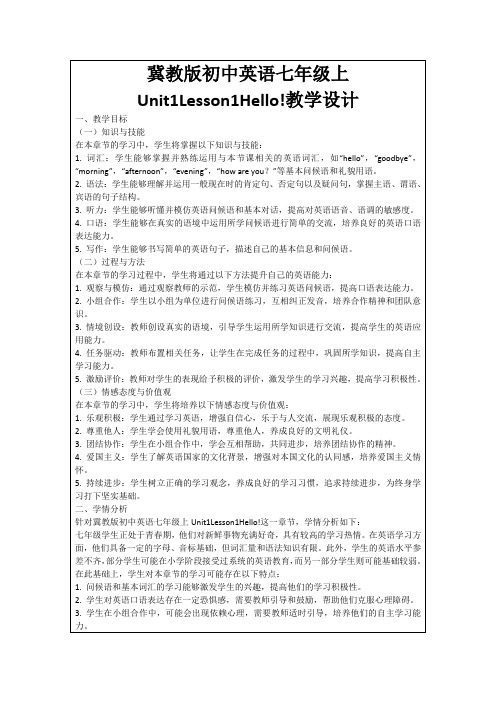
(一)导入新课
1.教师以一首英语歌曲《Hello Song》作为课堂导入,激发学生的学习兴趣,同时让学生在轻松愉快的氛围中感知英语问候语。
2.教师展示一张问候语的图片,引导学生观察并说出图片中的英语问候语,如“hello”,“morning”等。
3.教师与学生进行简单的英语问候语互动,让学生在实际交流中感受英语学习的乐趣。
2.语法:本章节的语法教学重点是一般现在时的肯定句、否定句和疑问句。难点在于学生对句子结构的掌握,尤其是疑问句的构成。
3.口语:口语表达是本章节的重点,要求学生能够流利地使用问候语进行简单的交流。难点在于学生克服开口恐惧,大胆进行口语表达。
4.文化背景:融入英语国家的文化背景,帮助学生了解和尊重不同文化,这是本章节的教学难点。
2.尊重他人:学生学会使用礼貌用语,尊重他人,养成良好的文明礼仪。
3.团结协作:学生在小组合作中,学会互相帮助,共同进步,培养团结协作的精神。
4.爱国主义:学生了解英语国家的文化背景,增强对本国文化的认同感,培养爱国主义情怀。
5.持续进步:学生树立正确的学习观念,养成良好的学习习惯,追求持续进步,为终身学习打下坚实基础。
4.教师强调英语学习的重要性,鼓励学生积极参与课堂活动,持续提高英语水平。
五、作业布置
为了巩固本章节所学知识,特布置以下作业:
1.词汇巩固:请学生将本节课所学的问候语词汇整理成单词卡片,每个词汇写上英文、中文以及例句,加强记忆。
2.口语练习:学生与家长或朋友一起进行英语问候语对话练习,录制视频,要求每位学生至少录制3个不同的场景对话,提高口语表达能力。
3.学生互相交流问候语的使用场景,分享学习心得,提高口语表达能力。
(四)课堂练习
Unit 1 1 Hello教案 冀教版七年级上册英语

Unit 1School and FriendsLesson 1: Hello!教学目标通过本课节的教学,学生达成以下目标:1.知识目标掌握单词:Canada接触单词:Jenny, Danny, thanks短语和句型:be from, What’s your name? My name is.../I’m...How are you? I’m fine. And you? Nice to meet you, too.2.能力目标(1)学会用英语问候和打招呼;(2)能用英语自我介绍。
3.情感目标养成礼貌问候他人的好习惯。
重点难点1.重点:掌握本课节的英语问候语和打招呼用语。
2.难点:能用英语自我介绍。
教学准备PPT 课件;本课节用到的录音。
授课时数1课时教学过程Step 1 Warming upHave a free talk.The teacher introduces himself/herself. Write his/her name on the blackboard. Say: Hello. Welcome to my English class. I’m/My name is… (Liu Daming). What’s your name?Ask the students’ names one by one.Step 2 Presentation1. Present how to say and write Chinese names in English.Chinese names are made up of surnames and given names. Write them separately, and the first letters of surnames and given names are written in capital letters.2. Teach the new phrase and sentences.(1) Teach be from using the picture.I’m Liu Daming. I am from China.be from…来自……(2) Teach —What’s your name?—I’m/My name is…Step 3 PracticePractice the following conversation in pairs.A: Hello, I’m...! I’m from China. What’s your name?B: Hello, I’...! I’m from China, too.Step 4 PresentationTeach the words: Canada, Jenny, Danny using the pictures.Step 5 Listening, reading and acting (Part 1)1. Play the recording of Part 1 for the students to listen and read following it.2. Get the class to read the sentences by themselves.3. Act it out in group of three.Step 6 Presentation1. Show the conversation between teacher and a student.T: What’s your name?S: I’m...T: How are you?S: I’m fine. And you?T: I’m good, thanks. Nice to meet you.S: Nice to meet you, too.2. Explain some sentences for the class.I’m... = My name is...I’m fine. = I’m good.And you?= And how are you?thanks = thank youNice to meet you.的答语为Nice to meet you, too.Step 7 PracticeGet the class to make the conversation like this and practice it.A: Hello! I’m... I’m from... What’s your name?B: Hi! I’m... I’m from..., too.A: How are you?B: I’m fine/good. And you?A: I’m fine/good, thanks. Nice to meet you.B: Nice to meet you, too.Step 8 Listening, reading and acting (Part 2)1. Play the recording of Part 2 for the class to listen and read following it.2. Practice the conversation in pairs.3. Act out the conversation in front of the class.Step 9 Listening and singing1. Play the recording of Exercise 1 in Let’s Do It! for the class to listen and sing along together. Make sure the class can sing it by themselves.2. Change the names Joe and Sue into their own names, then sing it.Step 10 Playing a gamePlay the game Stop and Go. Play this game to practice greeting your friends.A: Hello! My name is... What’s your name?B: Hi! My name is... How are you?A: I’m fine. Nice to meet you!Step 11 Numbering the sentencesGet the class to finish the Exercise 3in Let’s Do It! Then check them.Answers (自上而下): 2 1 3Step 12 SummarySum up what we’ve learnt in this period with the class.1. Hello, I’m...2. I’m from...3. A: What’s your name?B: My name is...4. A: How are you?B: Fine, thanks.5. A: Nice to meet you.B: Nice to meet you, too.Step 13 Language points1. I’m from China. 我来自中国。
冀教版七年级上册Unit1Lesson1Hello!课教学设计

5.家庭作业:家长协助学生完成以下任务:
a.与孩子一起制作问候语卡片,送给亲朋好友。
b.与孩子一起进行英语问候语和自我介绍的角色扮演,增进亲子互动。
6.阅读拓展:推荐学生阅读一些关于问候和自我介绍的英文小故事,了解不同文化背景下的问候方式,拓宽视野。
1.写作练习:请学生用英语写下自己的自我介绍,包括姓名、年龄、来自哪里以及兴趣爱好等,要求尽量使用本节课所学的新单词和句型。
2.视频录制:学生可以邀请家人或朋友参与,共同录制一段问候语和自我介绍的短视频,要求对话内容自然、流畅,能够体现出所学知识。
3.课后实践:鼓励学生在课后与家人、朋友用英语进行问候和自我介绍,记录下交流过程中的有趣瞬间,增强实际运用能力。
3.培养学生运用简单的英语进行自我介绍,如“My name is...”、“I'm from...”等,并能够理解他人的基本信息。
4.帮助学生掌握英语基本句型,如“Nice to meet you!”、“How are you?”等,并能用于日常交流。
5.使学生了解英语字母的发音,掌握字母表的顺序,为后续学习英语单词和发音打下基础。
4.通过学习英语,让学生了解世界各地的文化差异,培养他们的跨文化交际意识。
5.激发学生的爱国情怀,让他们在学习英语的同时,不忘弘扬中华民族的优秀文化。
二、学情分析
针对冀教版七年级上册Unit1 Lesson1 Hello!这一章节,学情分析如下:
七年级学生正处于青春期,他们对新鲜事物充满好奇,学习积极性较高。在此基础上,学生对英语的学习兴趣较为浓厚,但英语基础和能力参差不齐。大部分学生对基本的英语问候语和自我介绍已有一定了解,但在实际运用中可能存在发音不准确、词汇量有限等问题。
冀教版七年级英语上册同步教案unit 1 lesson 1 hello
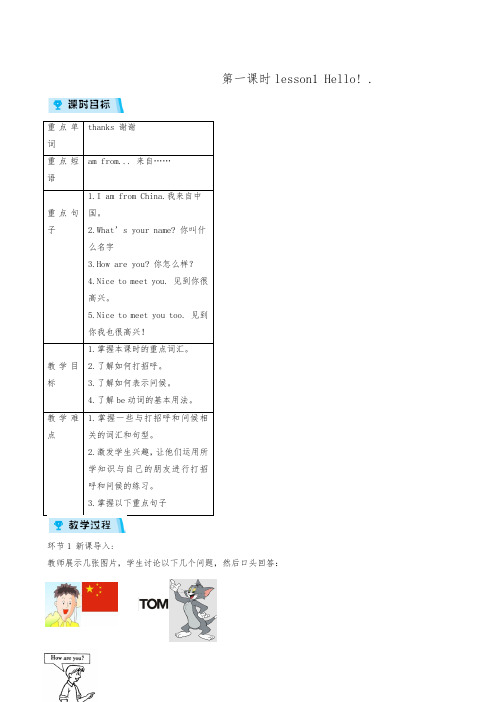
第一课时lesson1 Hello! .环节1 新课导入:教师展示几张图片,学生讨论以下几个问题,然后口头回答:(1)Where is Mingming from?(2)What’s the name of the cat?(3)Someone say: “How are you?, and you say: “!”(4)Someone say: “Nice to meet you!”And you say: “ !”设计意图:通过图片引入,引起学生疑问,激发学生对见面问好的兴趣,为新课做准备。
环节2 学习活动1.听录音,听完讨论并口头回答以下问题:(1)Where is Danny from?(2)How is Li Ming?2.教师教读本课的对话内容,然后同桌一起练习,熟读对话。
3.教师请几对同学起来表演。
指出学生表现得好的地方和不足之处,要适当鼓励。
4.听练习题1的录音,大家跟着录音一起唱。
5.学生四人为一组,编对话,相互询问对方的姓名,国籍等问题。
对话中要用到下列句子:What’s your name?How are you?Where are you from?Nice to meet you.6.教师请三组学生起来表演他们的对话,然后作点评。
表现得好的小组获得奖励。
7.教师随机抽取四名学生到讲台上表演,参照练习题2的游戏进行对话,教师在一边指导和配合表演。
8.学生完成练习题3,按打招呼的正确顺序,题中的三句话排序。
9.学以致用。
(1)同义句转换:I am Jenny.My name is Jenny.(2)用be的正确形式完成对话。
Joe: Hello. I am Joe. What is your name?Sue:My name is Sue.(3)根据句意完成对话。
Joe: Hi,nice to meet you!Sue:Hi, nice to meet you, too.设计意图:通过简单的自我介绍练习和日常见面打招呼的方式,让学生初步学会如何用英语介绍自己、问候对方。
秋冀教版英语七年级上册unit 1《lesson 1 hello!》优秀教案(重点资料).doc
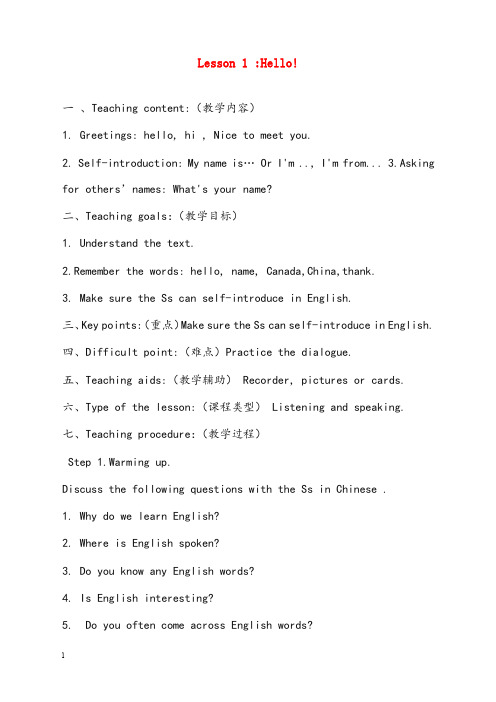
Lesson 1 :Hello!一、Teaching content:(教学内容)1. Greetings: hello, hi , Nice to meet you.2. Self-introduction: My name is… Or I'm .., I'm from...3.Asking for others’names: What's your name?二、Teaching goals:(教学目标)1. Understand the text.2.Remember the words: hello, name, Canada,China,thank.3. Make sure the Ss can self-introduce in English.三、Key points:(重点)Make sure the Ss can self-introduce in English.四、Difficult point:(难点)Practice the dialogue.五、Teaching aids:(教学辅助) Recorder, pictures or cards.六、Type of the lesson:(课程类型) Listening and speaking.七、Teaching procedure:(教学过程)Step 1.Warming up.Discuss the following questions with the Ss in Chinese .1. Why do we learn English?2. Where is English spoken?3. Do you know any English words?4. Is English interesting?5. Do you often come across English words?Step 2. Lead in. Discuss these questions:1. What do you say when you meet someone?2.Do you know what Canadians say when they meet?3. How do you introduce yourself or someone else in Chinese?4.Do you know how to introduce someone in English?Today we’re going to learn something about them. Do you want to know?Step 3. New lesson:No. 1 Hello/Hi, my name is1. PresentationPretend to meet someone. Say “Hello” or “Hi”, I'm ....,I'm from........ (自我介绍)self-introduceMake sure the Ss can understand it. Encourage them to repeat. 2. PracticeWork in pairs. Encourage the Ss to greet each other and introduce themselves. Then ask some pairs to act it out.No. 2. How are you?1. Presentation.Say “I'm ___. What’s your name?” Translate if necessary. Then repeat a few times. Encourage the Ss to follow until they can say it correctly.2. Practice. Work in pairs. Encourage the Ss to practice the dialoguein pairs. Demonstrate the dialogue with one or two Ss, and then ask some pairs to act it out for the rest of the class. Demonstrate and practice the dialogue:(A)Hello! I'm ___. What’s your name?(B)My name is ____ .how are you?...........Step 4. Play the tape for the Ss to follow.Step 5.Summary. (小结)Sum up the greeting and response, combining with the useful expressions in this lesson.Step 6. Homework.(作业)Remember the new word and practice the dialogue.Step 7.Blackboard-writing:(板书)the useful expressions八.Teaching reflection:(课后反思)。
Lesson1hello!教案2023-2024学年冀教版英语七年级上册

3.学生可能遇到的困难和挑战:在学习本节课的内容时,学生可能遇到的困难和挑战主要包括:对新词汇和句型的记忆和理解,特别是对于一些日常英语交际用语的运用;在口语表达中,可能存在发音不准确、语法使用不熟练等问题;在听力理解方面,可能对一些快速的英语口语交流有所困难;在跨文化交际方面,可能对西方的日常交际礼仪不太了解,导致在实际交流中出现困惑和尴尬。
教学资源
1.软硬件资源:多媒体教室、投影仪、计算机、音响设备、黑板、粉笔。
2.课程平台:学校教学管理系统、英语学习软件。
3.信息化资源:英语教学课件、视频资料、音频资料、在线英语学习网站。
4.教学手段:讲解法、示范法、练习法、任务型教学法、合作学习法、情景模拟法。
教学过程设计
1.导入新课(5分钟)
目标:引起学生对英语问候语和日常交际用语的兴趣,激发其学习欲望。
过程:
将学生分成若干小组,每组选择一个与英语问候语和日常交际用语相关的主题进行深入讨论。
小组内讨论该主题的现状、挑战以及可能的解决方案。
每组选出一名代表,准备向全班展示讨论成果。
5.课堂展示与点评(15分钟)
目标:锻炼学生的表达能力,同时加深全班对英语问候语和日常交际用语的认识和理解。
过程:
各组代表依次上台展示讨论成果,包括主题的现状、挑战及解决方案。
目标:让学生了解英语问候语和日常交际用语的基本概念、组成部分和用法。
过程:
冀教版初中英语七年级上册教学设计Lesson 1 Hello(教案)

冀教版初中英语七年级上册教学设计Lesson 1 Hello一、Teaching content:1. Greetings: hello, hi2. Self-introduction: My name is…3.Asking for others’names: What’s your/his/her name?二、Teaching goals1. Understand the text2.Remember the words: hello, name, my, your, his, her, I, is, what3. Make sure the Ss can introduce each other in English三、Key points:What’s your/his/her name?My /his/her name is …四、Difficult point: What’s his/her name?五、Preparation: A map of China and a map of Canada; some pictures of characters such as Sun Wukong, LanMao and so on.六、Teaching aids: Recorder, pictures or cards七、Type of the lesson: Listening and speaking八、Teaching procedureStep 1.Warming up. Discuss the following questions with the Ss in Chinese1. Why do we learn English?2. Where is English spoken?3. Do you know any English words?4. Is English interesting?5. Do you often come across English words?Step 2. Lead in. Discuss these questions:1. What do you say when you meet someone?2.Do you know what Canadians say when they meet?3. How do you introduce yourself or someone else in Chinese?4.Do you know how to introduce someone in English?Today we’re going to learn something about them. Do you want to know?Step 3. New lesson:No. 1 Hello/Hi, my name is1. PresentationPretend to meet someone. Say “Hello”or “Hi”, my name is…. Make sure the Ss can understand it. Encourage them to repeat.2. PracticeWork in pairs. Encourage the Ss to greet each other and introduce themselves. Then ask some pairs to act it out.No. 2. What’your/his/her name1. PresentationSay “My name is___. What’s your name?”Translate if necessary. Thenrepeat a few times. Encourage the Ss to follow until they can say it correctly.2. PracticeWork in chain like this:A: (to B) My name is ___. What’s your name?B: My name is ___. (to C) What’s your name?C: …Then ask some Ss to act it out.3. Presentation and practice: What’s his/ her name?Show a picture of LAN Mao and say, “What’s his name? His name is Lan Mao”. Ask the question and help the Ss to answer. Then repeat. Work in pairs to practice the dialogue and ask some pairs to act it out.4. Introduce the characters on the textbook: Li Ming, Jenny, and Danny. Teach the words China and Canada, using maps of them. Then explain the sentence “I live in___.”5.Listen and follow6. Play the tape for the Ss to follow.7.Summary.Sum up the lesson briefly by practicing all the dialogues in the text.8. HomeworkRead the text and practice the dialogue.。
冀教版七年级上册Lesson 1 《Hello!》教学设计
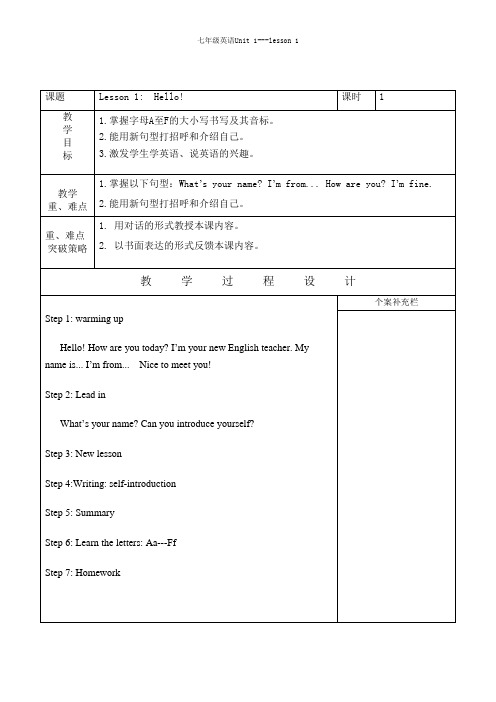
Lesson 1: Hello!
课时
1
教
学
目
标
1.掌握字母A至F的大小写书写及其音标。
2.能用新句型打招呼和介绍自己。
3.激发学生学英语、说英语的兴趣。
教学
重、难点
1.掌握以下句型:What’s your name? I’m from... How are you? I’m fine.
2.能用新句型打招呼和介绍自己。
3.什么__h__t
4.谢谢th__ __ks
5.认识m__ __t
6.好的f__n__
二、根据汉语意思补全句子
1.我的名字叫王红。
______ ______ is Wang Hong.
2.你叫什么名字?
______ your ______?
3.我来自加拿大。
I'm ______ ______.
4.——你好吗?——很好,谢谢。
1. Work in pairs to practice the following sentences:
(1) Hello/Hi! My name is... What’s your name?
(2) ---How are you?
---I’m fine. And you?
(3)Nice to meet you, too.
2. Play the tape for the Ss to follow.
3. Let’s Do It!
Step4:Writing: self-introduction
Step 5:Learn the letters: Aa---Ff
个案补充栏
精练
一、补全单词
1.来自fr__m
冀教版七年级上册Unit1Lesson1Hello!课优秀教学案例
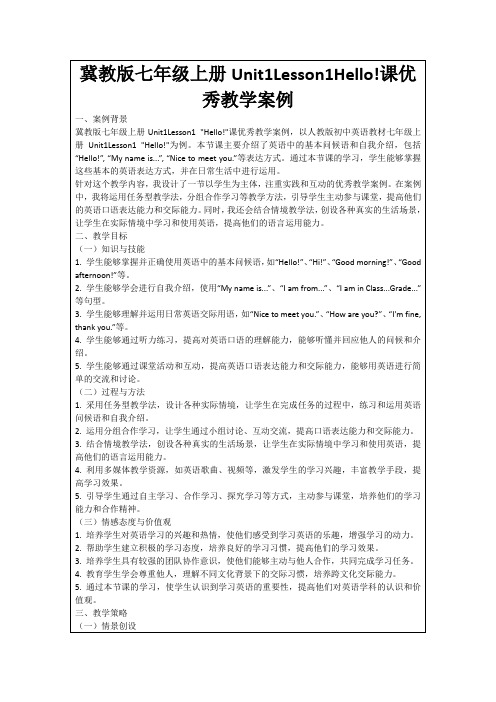
(四)总结归纳
1.教师可以引导学生回顾和总结本节课所学的英语问候语和自我介绍的表达方式,帮助他们巩固所学知识。
2.教师可以组织学生进行小组总结,让学生在小组内分享自己的学习收获和体会,通过小组总结,促进学生之间的交流和互助。
3.学生能够理解并运用日常英语交际用语,如“Nice to meet you.”、“How are you?”、“I'm fine, thank you.”等。
4.学生能够通过听力练习,提高对英语口语的理解能力,能够听懂并回应他人的问候和介绍。
5.学生能够通过课堂活动和互动,提高英语口语表达能力和交际能力,能够用英语进行简单的交流和讨论。
(二)讲授新知
1.教师可以通过讲解和示范的方式,向学生介绍英语中的基本问候语和自我介绍的表达方式。例如,教师可以讲解“Hello!”、“Hi!”、“Good morning!”、“Good afternoon!”等问候语的用法,并示范如何正确使用这些问候语进行交流。
2.教师可以引导学生学习如何进行自我介绍,例如,教师可以给出一个自我介绍的例子:“My name is Wang Lin. I am in Class 7, Grade 7. I am from Beijing.”,并让学生模仿和练习如何介绍自己。
(二)过程与方法
1.采用任务型教学法,设计各种实际情境,让学生在完成任务的过程中,练习和运用英语问候语和自我介绍。
2.运用分组合作学习,让学生通过小组讨论、互动交流,提高口语表达能力和交际能力。
3.结合情境教学法,创设各种真实的生活场景,让学生在实际情境中学习和使用英语,提高他们的语言运用能力。
Unit1Lesson1Hello!教案冀教版英语七年级上册

Unit 1 Lesson 1:Hello!教学目标:1、学会用英语问候和打招呼;2、能用英语自我介绍。
教学重难点:重点:掌握本课节的英语问候语和打招呼用语。
难点:能用英语自我介绍。
教学过程:PracticeA: Hello, I’m ...! I’m from China.What’s your name?B: Hello, I’...! I’m from China, too.I’m from Canada, too.tooadv. 也用于肯定句句末常用逗号与前面的句子隔开表示后者也具有前者所说的情况e.g.He is a student.I’m a student, too.What’s your name?What’s your name?你叫什么名字?询问他人姓名的句型;回答时用My name is …或者直接回答姓名。
How are you?How are you?你好吗?打招呼的常用语用于询问对方的身心状态怎么样回答时用I’m fine.或Fine/Very well.等Sing the song with the students’own names. Hello, hello, how are you?What’s your name?My name is ....Hello, hello, how are you?What’s your name?My name is ....Hello, hello, how are you?Fine. Nice to meet you.Stop and Go! Play this game to practice greeting your friends.A: Hello! My name is .... What’s your name?B: Hi! My name is .... How are you?A: I’m fine. Nice to meet you!How can you introduce yourself to a new friend? Number the sentences in the correct order._______ I’m from Canada,_______ Hello! I’m Danny._______ Nice to meet you.Sum up1. Hello, I'm ....2. I'm from ....3. A:What's your name?B:My name is ....4. A:How are you?B: Fine, thanks.5. A: Nice to meet you.B: Nice to meet you, too.根据汉语或首字母提示完成句子1.I (是)Jenny.2.Jenny is from (加拿大).3.My name (是) Wang Mei.4.—W is your name, please?—I’m Tony.5.Li Ming is from Beijing, C .根据汉语意思完成句子。
冀教版英语七上Unit 1《Lesson 1 Hello!》教学设计
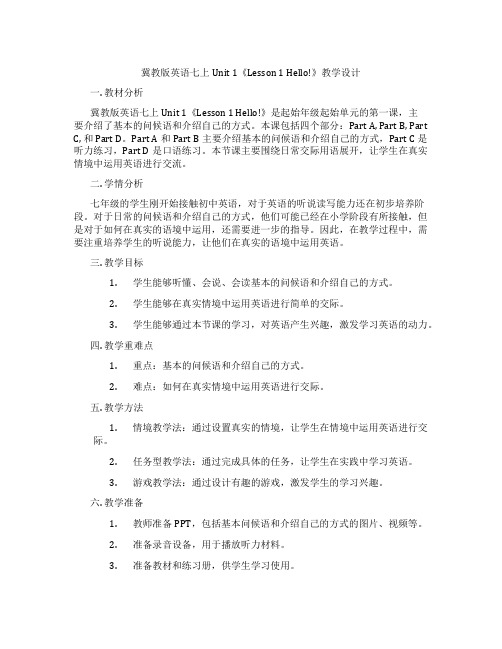
冀教版英语七上Unit 1《Lesson 1 Hello!》教学设计一. 教材分析冀教版英语七上Unit 1《Lesson 1 Hello!》是起始年级起始单元的第一课,主要介绍了基本的问候语和介绍自己的方式。
本课包括四个部分:Part A, Part B, Part C, 和 Part D。
Part A和Part B主要介绍基本的问候语和介绍自己的方式,Part C是听力练习,Part D是口语练习。
本节课主要围绕日常交际用语展开,让学生在真实情境中运用英语进行交流。
二. 学情分析七年级的学生刚开始接触初中英语,对于英语的听说读写能力还在初步培养阶段。
对于日常的问候语和介绍自己的方式,他们可能已经在小学阶段有所接触,但是对于如何在真实的语境中运用,还需要进一步的指导。
因此,在教学过程中,需要注重培养学生的听说能力,让他们在真实的语境中运用英语。
三. 教学目标1.学生能够听懂、会说、会读基本的问候语和介绍自己的方式。
2.学生能够在真实情境中运用英语进行简单的交际。
3.学生能够通过本节课的学习,对英语产生兴趣,激发学习英语的动力。
四. 教学重难点1.重点:基本的问候语和介绍自己的方式。
2.难点:如何在真实情境中运用英语进行交际。
五. 教学方法1.情境教学法:通过设置真实的情境,让学生在情境中运用英语进行交际。
2.任务型教学法:通过完成具体的任务,让学生在实践中学习英语。
3.游戏教学法:通过设计有趣的游戏,激发学生的学习兴趣。
六. 教学准备1.教师准备PPT,包括基本问候语和介绍自己的方式的图片、视频等。
2.准备录音设备,用于播放听力材料。
3.准备教材和练习册,供学生学习使用。
七. 教学过程1.导入(5分钟)教师通过播放一首英文歌曲,引导学生跟着歌曲一起唱,激发学生的学习兴趣。
然后,教师向学生问好,引导学生用英语回答,从而引出本节课的主题——基本的问候语。
2.呈现(10分钟)教师通过PPT展示基本问候语的图片和视频,让学生直观地感知和学习这些问候语。
冀教版七年级英语上册Lesson1Hello教学设计

在总结归纳环节,教师采取以下方式帮助学生巩固所学内容:
1.教师引导学生回顾本节课所学问候语、自我介绍的表达方式,总结重点知识点。
2.学生分享自己在课堂中学到的最有价值的知识,以及在学习过程中遇到的困难和解决办法。
3.教师对本节课学生的表现给予肯定和鼓励,提醒他们课后继续练习,巩固所学知识。
(二)讲授新知
在讲授新知环节,教师通过以下步骤引导学生学习本节课的重点内容:
1.教师呈现本节课的重点问候语,如“Hello!”、“Hi!”、“Good morning!”、“Good afternoon!”、“Goodbye!”等,并带领学生朗读、模仿。
2.针对每个问候语,教师给出一个具体的情境,让学生进行角色扮演,练习使用问候语。例如,在早晨见到同学时,用“Good morning!”问候;在下午见到朋友时,用“Good afternoon!”问候。
2.技能目标:培养学生运用英语进行自我介绍和问候他人的能力,提高学生的听说能力和口语表达能力。使学生在真实的语言环境中,能够灵活运用所学知识进行简单的英语交流。
(二)过程与方法
1.过程目标:通过小组合作、情景模拟、角色扮演等形式,让学生在实际操作中掌握英语问候语和自我介绍的表达方式。同时,教师引导学生通过观察、模仿、实践等方式,提高英语听说能力。
冀教版七年级英语上册Lesson1Hello教学设计
一、教学目标
(一)知识与技能
1.知识目标:通过本课的学习,学生能够掌握基本的英语问候语,如“Hello!”、“Hi!”、“Good morning!”、“Good afternoon!”、“Goodbye!”等,并能够运用这些问候语进行简单的日常交流。同时,学生需要掌握本课出现的重点词汇和短语,如“morning”、“afternoon”、“classmate”、“nice to meet you”等。
冀教版七年级上册英语Lesson1Hello教学设计
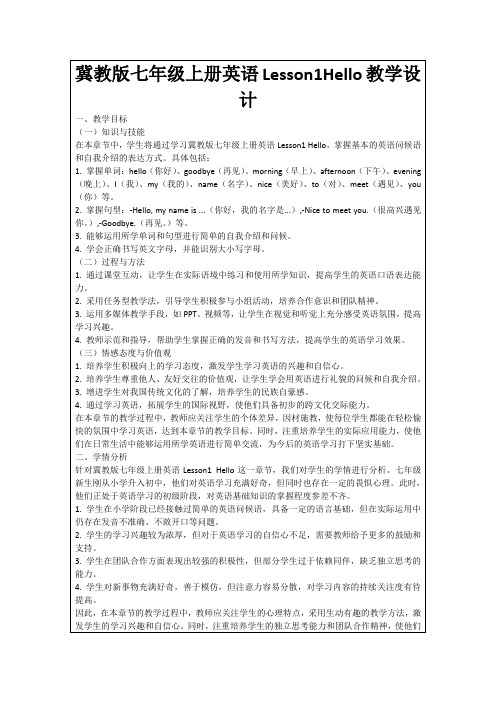
3.教师讲解单词和句型的用法,结合实际情境进行示范,让学生更好地理解。
4.学生跟随教师一起练习,互相问候并自我介绍。
(三)学生小组讨论(500字)
1.教师将学生分成小组,每组选定一个组长,负责组织和协调小组活动。
2.教师给出讨论话题:Share your favorite greeting words and introduce yourself.(分享你最喜欢的问候语并自我介绍。)
3.重点:让学生掌握英文字母的大小写书写方法。
难点:纠正学生错误的书写习惯,使他们能够熟练、规范地书写英文字母。
(二)教学设想
1.创设真实语境,让学生在互动中学习。通过角色扮演、小组讨论等形式,让学生在实际语境中练习所学知识,提高口语表达能力。
2.采用多样化的教学手段,激发学生学习兴趣。运用多媒体、游戏、歌曲等多种教学手段,丰富课堂内容,提高学生的学习积极性。
2.培养学生尊重他人、友好交往的价值观,让学生学会用英语进行礼貌的问候和自我介绍。
3.增进学生对我国传统文化的了解,培养学生的民族自豪感。
4.通过学习英语,拓展学生的国际视野,使他们具备初步的跨文化交际能力。
在本章节的教学过程中,教师应关注学生的个体差异,因材施教,使每位学生都能在轻松愉快的氛围中学习英语,达到本章节的教学目标。同时,注重培养学生的实际应用能力,使他们在日常生活中能够运用所学英语进行简单交流,为今后的英语学习打下坚实基础。
4.学生进行小组合作,共同完成一道课堂实践题:Design a dialogue between two people greeting and introducing themselves.(设计一个两个人问候并自我介绍的对话。)
冀教版七年级上册 Unit1 Lesson 1 Hello! 课教学设计

Lesson1 Hello! 教学设计【教学目标】1.知识与能力:要求能正确地读出如下单词:Canada, thanks,Jenny,Danny并要求会拼Canada . be from2.过程与方法:通过自主学习完成任务,提出质疑并大胆探究,积极交流,巩固当堂知识,反馈学情。
3.情感态度和价值观:学会日常简单的自我介绍,包括姓名,国籍;并会问候他人。
【教学重难点】日常简单的自我介绍,问候。
注意当别人问候时要作出礼貌性的答谢语。
【课时安排】1课时【教学过程】一、导入环节(2分钟)(一)导入新课,板书课题导入语:Good morning, class. How are you? Today, we are going to learn:Lesson 1 Hello!(二)出示学习目标过渡语:First ,let’s read the learning goals together.1.我能正确地读出Canada, thanks,Jenny,Danny并要求会拼Canada . be from2.学会日常简单的自我介绍,包括姓名,国籍;并会问候他人。
过渡语:I believe everyone can achieve your goal? Can you ? Let’s begin .二、先学环节(15分钟)过渡语:First look at the guides carefully and then finish the tasks step by step.(一)出示自学指导1.朗读并熟记本课单词(P131),完成自学检测(1)。
2.听录音,朗读课文,完成自学检测(2).3.背诵对话,完成自学检测(3)(二)自学检测反馈(1)单词识记1)詹妮__________ 2)加拿大_________ 3)丹尼__________ 4)谢谢__________5)你叫什么?________________________ 6)你好吗?___________________________ 7)见到你很高兴_________________________(2)翻译下列句子。
冀教2011版七年级英语上册《Lesson1hello》说课稿

冀教2011版七年级英语上册《Lesson1hello》说课稿一、教材分析1. 教材内容本课是冀教版2011年版七年级英语上册的第一课,主要内容为学习和掌握英语的基本问候语和介绍自己的方式。
2. 教材重点本课的教学重点包括以下几个方面: - 学会基本的问候语:Hello, Hi, Good morning等; - 掌握自我介绍的方式:My name is…,I’m…years old,I’m from…等; - 能够与他人进行简单的问答对话。
3. 教材难点本课的难点主要集中在以下几个方面: - 学会正确运用问候语,并理解其在不同场景中的使用; - 掌握自我介绍的方式,包括姓名、年龄、来自哪里等内容。
二、教学目标1. 知识与技能目标通过本课的学习,学生将能够掌握以下知识与技能: - 认读与运用基本的问候语; - 掌握自我介绍的方式,并能正确表达自己的信息; - 学会进行简单的问答对话。
2. 过程与方法目标通过本课的学习,我们将培养学生以下过程与方法: - 合作学习:通过小组合作活动,激发学生的积极性与参与度; - 互动交流:通过问答、伙伴练习等形式,促进学生的口语交际能力的发展; - 观察探究:通过教师引导与学生自主发现,提高学生的自主学习能力。
三、教学重点与难点1. 教学重点•学习并掌握基本的问候语;•学习并掌握自我介绍的方式;•进行简单的问答对话。
2. 教学难点•学会正确运用问候语,并理解其在不同场景中的使用;•掌握自我介绍的方式,并能灵活运用。
四、教学过程1. 导入与感知(5分钟)教师可利用图片或实物向学生展示一些问候的场景,激发学生对话题的兴趣。
例如,教师可以展示一张早晨的阳光照片,引导学生讨论早晨问候的方式。
2. 呈现与示范(15分钟)教师通过PPT或课件展示基本的问候语,例如Hello, Hi, Good morning等,并对其发音进行示范。
随后,教师通过自我介绍的方式,示范给学生如何正确地介绍自己。
- 1、下载文档前请自行甄别文档内容的完整性,平台不提供额外的编辑、内容补充、找答案等附加服务。
- 2、"仅部分预览"的文档,不可在线预览部分如存在完整性等问题,可反馈申请退款(可完整预览的文档不适用该条件!)。
- 3、如文档侵犯您的权益,请联系客服反馈,我们会尽快为您处理(人工客服工作时间:9:00-18:30)。
1. Why do we learn English?
2. Where is English spoken?
3. Do you know any English words?
4. Is English interesting?
板
书
设
计
Lesson 1 :Hello!
What’s your name?你叫什么名字?
My name is…/I’m…我叫……(名字)
Nice to meet you.很高兴见到你。
Nice to meet you, too.我也很高兴见到你。
How are you?你好吗?
I’m fine. And you?我很好。你呢?
Say “I'm ___. What’s your name?” Translate if necessary. Then repeat a few times. Encourage the Ss to follow until they can say it correctly.
2. Practice. Work in pairs. Encourage the Ss topractice the dialogue in pairs. Demonstrate the dialogue with one or two Ss, and then ask some pairs to act it out for the rest of the class.
教学难点
Practice the dialogue.
教学方法
Listening and speaking,explaining,pairwork.
教学资源
Electronic whiteboard,Multimediacourseware
教学步骤
教师活动
学生活动
调整与思考
教
学
过
程
设
计
教
学
过
程
设
计
Step 1.Warming up.
Thinkirwork.
Repeat afterteacher.
Act the dialogue out.
Listen and follow.
作 业
Remember the new wordsand practice the dialogue.
Step 3. New lesson:
Part. 1 Hello/Hi, my name is
1. Presentation
Pretend to meet someone. Say “Hello” or “Hi”, I'm ....,I'm from........ self-introduce
Make sure the Ss can understand it. Encourage them to repeat.
3. How do you introduce yourself or someone else in Chinese?
4.Do you know how to introduce someone in English?
Today we’re going to learn something about them. Do you want to know?
5. Do you often come across English words?
Step 2. Lead in.
Askthese questions:
1. What do you say when you meet someone?
2.Do you know what Canadians say when they meet?
教
学
反
思
Step 5.Let’s Do It!
Ask students to listen and sing the song, then play the game, at last,do the exercises.
Step 5.Summary.
Sum up the greetingsand response, combining with the useful expressions in this lesson.
2. Practice
Work in pairs. Encourage the Ss to greet each other and introduce themselves. Then ask some pairs to act it out.
Part. 2. How are you?
1. Presentation.
Hello!
教学目标
1. Understand the text.
2.Remember the words: hello, name,Canada,China,thanks.
3. Make sure the Ss can self-introduce in English.
教学重点
Make sure the Ss can self-introduce in English.
Demonstrate and practice the dialogue:
(A)Hello! I'm ___. What’s your name?
(B)My name is ____ .how are you?
...........
Step 4. Play the tape for the Ss to follow.
